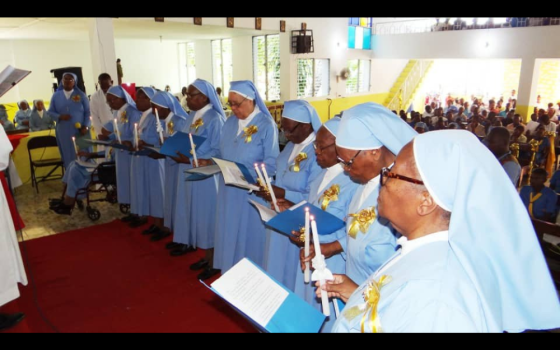COLUMN
Just days before Christians celebrated Christmas, Jesus got evicted.
In a strange twist of fate, he was removed from a hospital named after his adoptive father, St. Joseph. The whole saga took place in a desert. Only this time it was in Phoenix, Ariz., rather than Egypt.
Because a mother of four had her life saved under harrowing circumstances, the sacramental presence of Jesus was forced to evacuate a Catholic hospital in the Valley of the Sun. It’s a sad loss, really, since the body of Christ dwelt peacefully at St. Joseph’s for over 115 years.
It would be impossible to count how many fears were comforted, mourners were consoled, and wearied staff were nourished by the Mass or by sitting quietly in front of the Blessed Sacrament.
Bishop Thomas Olmsted, the hierarch who made the decision to pull the Eucharist from the chapel at St. Joseph’s Hospital, has been called “ ‘a man of the rules and a company man’ who puts the institutional church ahead of people,” according to an NCR report early last summer.
 |
You can sign up to receive email alerts each time Jamie Manson posts a new Grace on the Margins column. |
But one wonders whose rules he was playing by when he chose to rip the Catholic designation from this hospital founded by the Sisters of Mercy.
St. Joseph’s committee of ethicists employed both reason and compassion when they made their recommendation on this sad case of a woman whose pregnancy was literally killing her. Both the mother and the fetus were dying. If the mother died, this pregnancy could not be brought to term. Only the mother’s life could have been saved.
Olmsted seems to have had all the regard in the world for the unborn child. But where was his regard for the woman, or for her four children who would have been left motherless? Where is the regard for her husband? Isn’t it ironic that a bishop who is aggressively trying to preserve the institution of marriage and the sanctity of the family would be so willing to force a father into single parenthood? Would the church have stepped forward to help this father care for these four young children? Would they have offered him child care or free housekeeping or the benefit of an additional salary for the next 18 years?
One cannot overlook the trauma that the bishop is inflicting on this mother and her family. As a mother of four, there is little doubt that this woman is grief-stricken over this tragedy. Olmsted’s actions have no doubt exacerbated her pain, and have created harmful and unnecessary shame for this family. Imagine living with the knowledge that the decision to save your life led to the highly publicized, permanent removal of the Eucharist from a hospital?
In addition to the bishop’s disregard for the mother and her family, this particular incident seems to be laced with misogyny. In removing St. Joseph’s Catholic designation, Olmsted disparages centuries of devoted sacrifice not only on the part of the Sisters of Mercy, but by all women religious throughout the world who have healed untold numbers of lives. Olmsted’s excommunication in May of Mercy Sr. Margaret Mary McBride, a hospital administrator who served on the ethics committee, appears particularly targeted. It has become all too typical of the hierarchy to stamp out an esteemed woman religious who dares to use her expertise and authority to make a moral decision about another woman’s life.
If anyone doubts that misogyny played a role in this case, one need only recall that Olmsted is the product of a Vatican that, in March 2009, defended a Brazilian archbishop who excommunicated the mother of a 9-year-old girl who received an abortion after being raped by her stepfather. The father faced no ecclesiastical punishment.
But in the midst of this darkness, there is an unexpected beam of hope. The response of the staff of St. Joseph’s has demonstrated as much moral courage as it has deep theological truth. Not only have they refused to allow the hierarchy to use the Eucharist to bully them into submission, they have reaffirmed the holiness of their daily work. “St. Joseph’s will continue through our words and deeds to carry out the healing ministry of Jesus,” said Linda Hunt, president of St. Joseph’s Hospital. “Our operations, policies and procedures will not change.”
The incident involving St. Joseph’s should be a moment of awakening for the hierarchy. Real division is emerging. The flight of Catholics from parishes over the past two decades has demonstrated clear unrest among the faithful. But now institutions are reaching a breaking point. Those who once trembled in fear when the hierarchy wielded its power now tremble in holy anger.
Though St. Joseph’s can no longer call itself Catholic, it heralds a new vision of church.
Its break with the diocese is a moment of groundbreaking promise. By continuing the heart of its mission, the hospital will practice as a true community living out the sacraments.
Though they will be denied the opportunity to celebrate the Eucharist, the Eucharist will rise out of St. Joseph’s every time the sick are healed, the frightened are comforted, the lonely are visited, the weak are fed, and vigil is kept over the dying.
[Jamie L. Manson received her Master of Divinity degree from Yale Divinity School where she studied Catholic theology and sexual ethics. Her columns for NCR earned her a first prize Catholic Press Association award for Best Column/Regular Commentary in 2010.]
Editor's Note: We can send you an e-mail alert every time Jamie Manson’s column, "Grace on the Margins", is posted to NCRonline.org. Go to this page and follow directions: E-mail alert sign-up. If you already receive e-mail alerts from us, click on the "update my profile" button to add "Grace on the Margins" to your list.
|
For more information on the Phoenix hospital and Bishop Olmsted, see NCR's continuing coverage:
|


